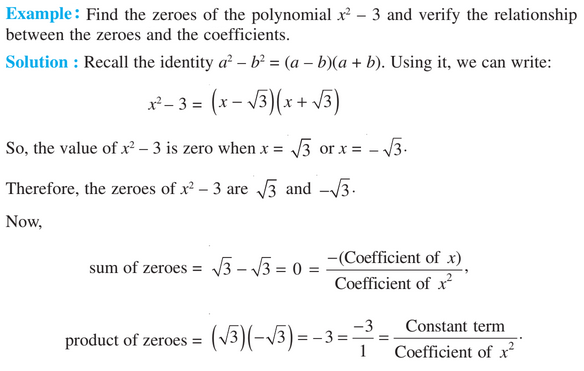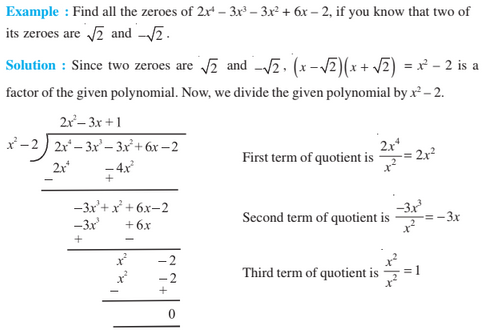What is a Polynomial?
A polynomial is defined as an expression of two or more algebraic terms. The term polynomial itself means “poly” (means many) and “nomial” (means terms). A polynomial can consist of constants, variables, and even exponents. Check out this detailed polynomials article to understand this topic in detail and to get further information.
Standard Form of a Polynomial:
[a0 xn + a1 xn – 1 + a2 xn – 2 + …….. + an x2 + an – 1 x + an]
Degree of a Polynomial:
In a polynomial, the highest power of the polynomial is referred to as the degree of the polynomial.
Types of Polynomials
There are three main types of polynomials which are linear, quadratic, and cubic polynomial according to the degree of that polynomial.
The above table can be explained as “a polynomial with degree 1 is known as a linear polynomial, a polynomial with degree 2 is binomial or quadratic polynomial, whereas with degree three is a cubic polynomial.”
Degree
|
Type of
Polynomial
|
1
|
Linear Polynomial
|
2
|
Quadratic Polynomial
|
3
|
Cubic Polynomial
|
The above table can be explained as “a polynomial with degree 1 is known as a linear polynomial, a polynomial with degree 2 is binomial or quadratic polynomial, whereas with degree three is a cubic polynomial.”
Root or Zeroes of a Polynomial
For any given polynomial, the value of x obtained by substituting the value of polynomial as 0 is known as the zero of the polynomial. These are also termed as roots of the equation. The Graphical meaning of the zeros of the polynomial is that the curve cuts the x-axis a point (k,0), where k is the root of the polynomial.
Notes: A polynomial of degree n will have n roots. So, any quadratic polynomial can only have a maximum of 2 zeroes and any cubic polynomial will have 3 zeroes maximum.
A quadratic equation ax2 + bx + c = 0 will have 2 roots, say α and β.
- The sum of roots (α + β = -b⁄a)
- Product of the roots (αβ = c⁄a)
Division Algorithm
According to division algorithm, any polynomial p(x) and any non-zero polynomial g(x), there exists polynomials q(x) and r(x) such that p(x) = g(x) q(x) + r(x), where r(x) = 0 or degree r(x) < degree g(x).
Example Questions
Example 1 (based on zeroes or roots of a polynomial)

Example 2 (based on division algorithm)

Also
Access
|
Practice Questions
- Find all the zeroes of2x4 – 3x3 – 3x2 + 6x – 2 if two of its zeroes are √2, and -√2
- Find all the zeroes of a polynomial 3x4 + 6x3 – 2x2 – 10x – 5 if two of its zeroes are given as: √(5⁄3), and -√(5⁄3)
- Calculate the values of a, and b if the zeroes of the polynomial x3 – 3x2 + x + 1 are a – b, a, a + b.
Access CBSE Class 10 Maths Sample Papers Here.
Access NCERT Class 10 Maths Book Here.
Related Polynomial Articles
- Polynomial Functions
- Degree Of A Polynomial
- Quadratic Formula & Quadratic Polynomial
- Factorization of Polynomials
- Revision Notes For CBSE Class 10 Maths Chapter 2 Polynomials
- Important Questions from Class 10 Polynomials
- Polynomial Division & Long Division Algorithm
- NCERT Solutions Class10 Maths Polynomials
To get more such maths and science notes for class 10, keep visiting BYJU’S. Also, get
various class 10 sample papers, questions papers, and other study materials to
prepare for the board exam more efficiently
prepare for the board exam more efficiently
MATHS Related Links
|
|
Derivative Examples
|
science https:
https://www.termsfeed.
com/privacy-
policy/
22ce6f85641
779175b
78aca8bf4e5e87
|


No comments:
Post a Comment